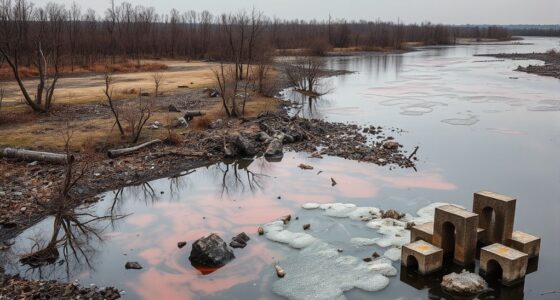During World War II, the shortage of natural rubber from Southeast Asia caused major disruptions to supplies, prompting you to see how scientists and industries worked together to find solutions. Rapid innovations in polymer chemistry led to the development of synthetic rubber, which was produced on an industrial scale for military needs like tires and aircraft parts. These wartime efforts not only supported the war but also laid the foundation for modern rubber technology—if you’re curious, there’s more to uncover about this pivotal period.
Key Takeaways
- WWII disrupted natural rubber supplies from Southeast Asia, prompting urgent development of synthetic rubber as an alternative.
- Scientific advances in polymer chemistry enabled large-scale production of durable synthetic rubber during wartime.
- Collaboration between government agencies, industry, and scientists accelerated synthetic rubber research and manufacturing efforts.
- Synthetic rubber became vital for military applications, including tires, aircraft parts, and tank components.
- Post-war innovations rooted in wartime needs continue to influence modern sustainable rubber technologies.
The Pre-War Rubber Industry and Its Challenges
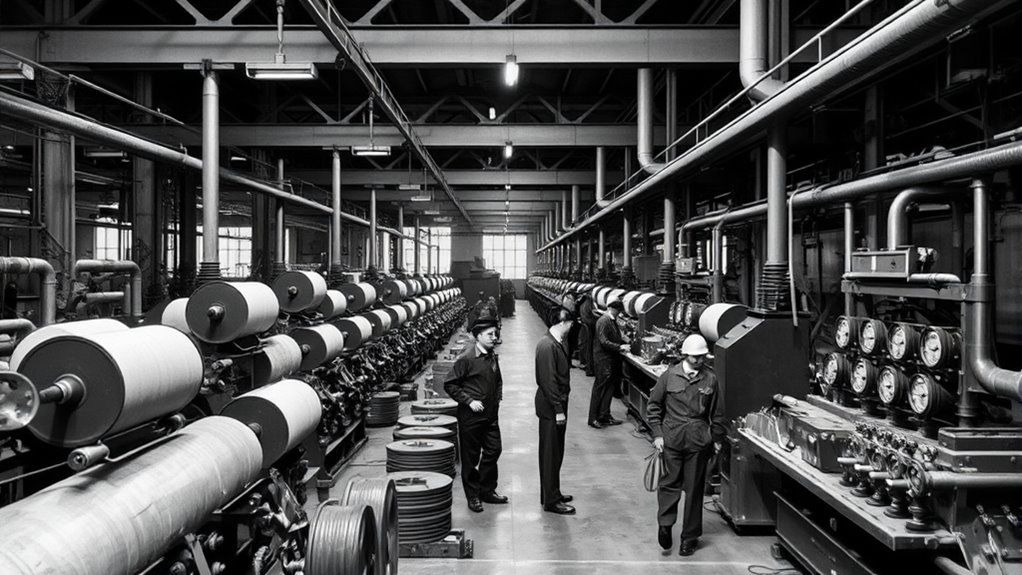
Before World War II, the rubber industry faced significant supply challenges because most natural rubber came from Southeast Asia, a region vulnerable to political instability and colonial control. You relied heavily on natural latex produced on rubber plantations, where climate and labor issues affected production. These plantations, often controlled by colonial powers, were prone to disruptions due to wars, political unrest, or natural disasters. As demand grew for rubber in industries like automobiles and defense, shortages became common, highlighting the fragility of dependence on Southeast Asian sources. This reliance limited your ability to meet global needs, prompting the search for alternative solutions. The pre-war rubber industry’s vulnerabilities exposed the urgent need for innovation, setting the stage for the development of synthetic rubber. Additionally, the threat of supply disruptions underscored the importance of developing synthetic alternatives, which could be produced domestically and more reliably. The development of synthetic rubber was driven by the necessity to create a more self-sufficient supply chain capable of supporting wartime needs. Recognizing the limitations of natural rubber sources, researchers began exploring chemical synthesis methods to produce rubber-like materials.
The Impact of Japanese Occupation on Southeast Asian Rubber Supplies

The Japanese occupation of Southeast Asia during World War II critically disrupted the region’s rubber supplies, forcing many industries to confront severe shortages. As Japanese forces took control of rubber-producing areas, access to essential resources became limited or cut off entirely. This occupation effectively halted the flow of raw rubber from key plantations in countries like Malaya, Thailand, and Indonesia. You would have faced rising costs and production delays, as natural rubber became scarce. The disruption created an urgent need for alternatives, but during this period, the supply chain collapse deeply impacted industries reliant on rubber, such as automotive and military sectors. The shortage underscored how vulnerable the global rubber supply was to geopolitical conflicts, prompting a search for synthetic substitutes.
The Urgent Need for Synthetic Alternatives

As the supply of natural rubber sharply declined due to wartime disruptions, industries faced an urgent need to develop synthetic alternatives. The reliance on natural rubber, crucial for tires, aircraft parts, and military equipment, became a critical issue because of disruptions in global trade, especially with Southeast Asia. The strategic importance of rubber led to government-backed research initiatives to accelerate synthetic production methods. With Japan controlling much of the natural rubber supply, shortages threatened wartime logistics and military operations. To meet demands, researchers and industries scrambled to find substitutes that could be produced domestically and more reliably. The scarcity pushed governments and scientists to prioritize synthetic rubber development, recognizing it as essential for maintaining wartime mobility and economic stability. This urgency spurred rapid innovation, laying the groundwork for the future of synthetic rubber production, including advancements in material science and manufacturing techniques. Additionally, the development of synthetic rubber contributed to the broader field of industrial materials, which has had lasting impacts beyond wartime applications.
Scientific Breakthroughs in Synthetic Rubber Development
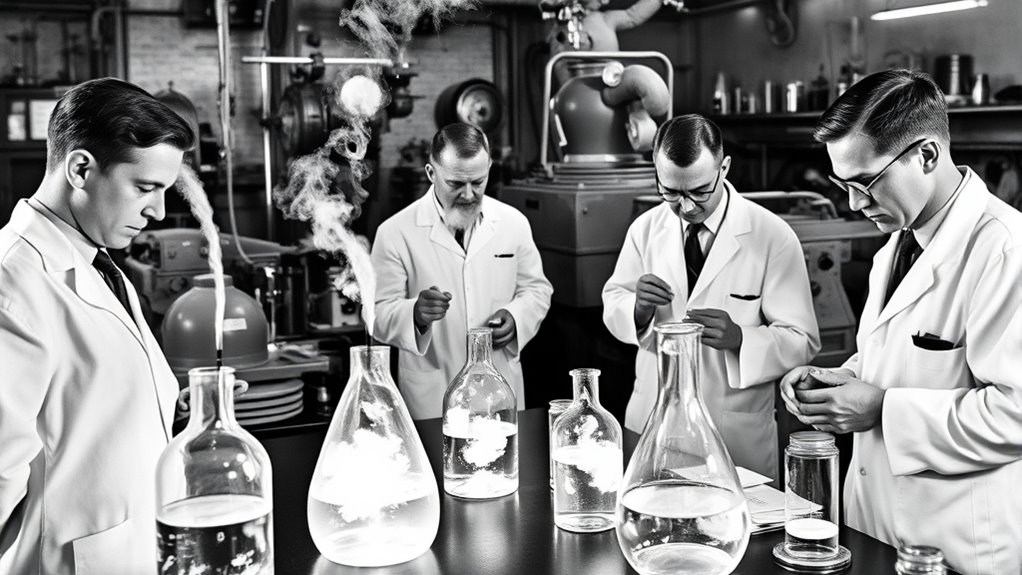
You’ll see how innovations in polymer chemistry enabled new possibilities for synthetic rubber production. Researchers also optimized catalytic processes to make manufacturing more efficient and scalable. These scientific breakthroughs played a vital role in meeting wartime demands.
Polymer Chemistry Innovations
During World War II, groundbreaking advances in polymer chemistry revolutionized synthetic rubber development, enabling scientists to create materials with properties comparable to natural rubber. You explore key innovations like biopolymer innovations, which provided sustainable sources and enhanced material performance. Additionally, new polymerization techniques allowed for more controlled and efficient synthesis processes. These breakthroughs included:
- Developing radical polymerization methods to produce high-quality synthetic rubbers rapidly.
- Innovating controlled/living polymerization to fine-tune molecular structures and properties.
- Incorporating biopolymer innovations that improved elasticity and durability, reducing reliance on natural rubber. Moreover, advances in Kia Tuning techniques helped optimize material properties for specific applications, demonstrating the interdisciplinary nature of scientific progress during this era. This period also saw significant scientific collaborations that accelerated research and development efforts. These advancements transformed the landscape of synthetic rubber, making production more adaptable and resilient during wartime shortages. The integration of polymer chemistry principles was crucial in overcoming material shortages and improving performance. Your understanding of these scientific breakthroughs highlights how polymer chemistry shaped the future of materials science.
Catalytic Process Optimization
Catalytic process optimization played a essential role in enhancing synthetic rubber production during World War II by increasing efficiency and reducing costs. By refining catalysts and reaction conditions, manufacturers could produce larger quantities of rubber faster and more reliably. This breakthrough directly impacted automotive manufacturing, enabling the rapid mass production of tires and other components fundamental for wartime vehicles. Additionally, improved catalytic processes contributed to the development of synthetic rubber suited for medical applications, such as flexible tubing and medical devices, where material quality and consistency mattered. These scientific advancements not only boosted wartime output but also laid the groundwork for post-war innovations. Your understanding of catalytic process optimization reveals how critical chemistry breakthroughs were in meeting wartime demands across multiple industries.
Key Figures and Organizations Behind Synthetic Rubber Innovation
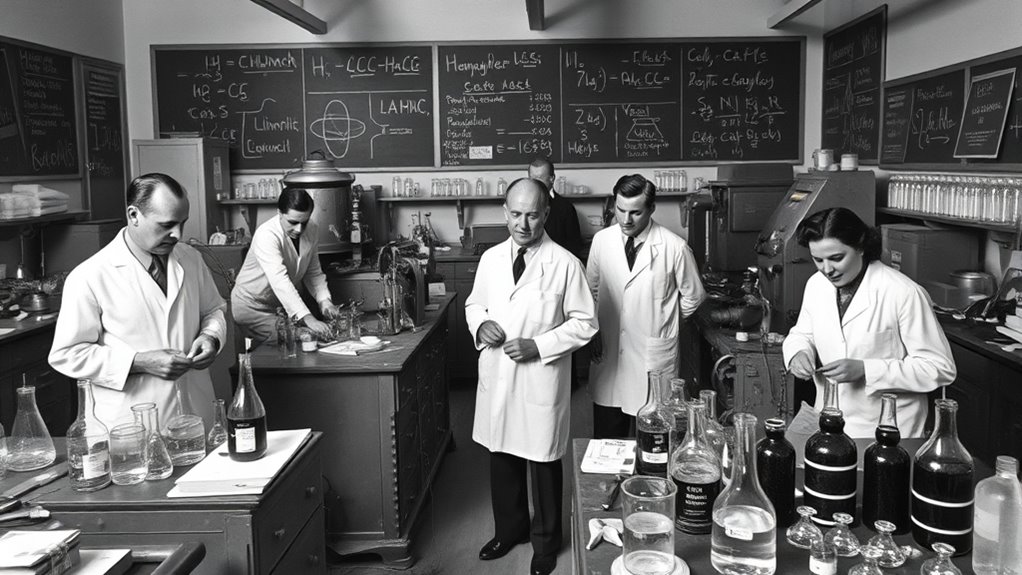
The development of synthetic rubber during World War II was driven by the efforts of key figures and organizations dedicated to overcoming supply shortages. Famous scientists and industry pioneers played pivotal roles in this breakthrough. You should note that:
- Researchers like Wallace Carothers and Leo Baekeland pioneered early polymer research that laid groundwork for synthetic rubber.
- Government agencies, including the U.S. Rubber Reserve and the Office of Rubber Reserve, coordinated funding and research efforts.
- Industrial organizations, such as the DuPont Company and Goodyear, led large-scale development and testing of synthetic alternatives.
These figures and organizations collaborated intensely, pushing scientific innovation forward. Their combined efforts accelerated the shift from natural to synthetic rubber, transforming wartime manufacturing and ensuring supply stability.
Industrial Scale Production and Technological Advancements

Building on the innovations driven by key figures and organizations, the focus shifted to producing synthetic rubber at an industrial scale to meet wartime demands. The surge in market demand pushed industries to rapidly expand production facilities and improve processes. Research funding increased markedly, enabling advancements in catalyst development, polymerization techniques, and automation. These technological improvements boosted yield, quality, and efficiency, helping supply the massive quantities needed. You would see factories operating around the clock, adopting new methods to scale up output without sacrificing consistency. The collaboration between government agencies, private companies, and scientists accelerated progress, ensuring synthetic rubber could be produced quickly and in large volumes. This rapid industrialization was vital in reducing reliance on natural rubber and supporting the war effort. Industrial Scale Production greatly advanced during this period, reflecting the wartime innovation urgency and importance of wartime innovation. Enhanced manufacturing processes played a crucial role in meeting the extraordinary wartime demands.
The Role of Synthetic Rubber in War Efforts and Military Applications
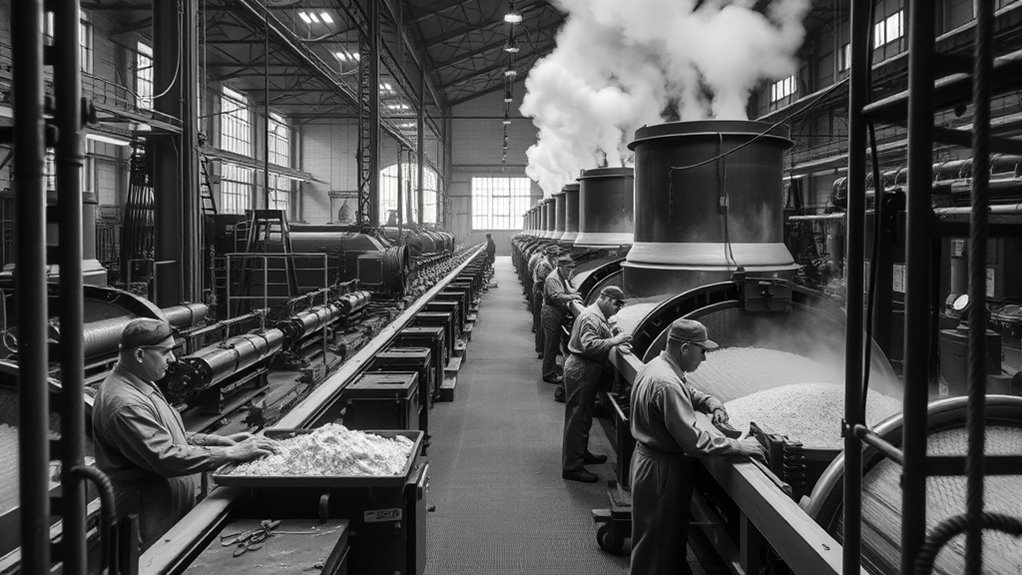
During World War II, synthetic rubber became essential for military equipment and vehicles. You’ll see how it was used in tires for military trucks, aircraft parts, and tank components. Its vital role extended to naval vessels and other crucial war efforts. Moreover, the demand for synthetic rubber led to the development of manufacturing processes that could produce large quantities efficiently. These innovative processes helped meet the urgent war-time needs and supported industrial resilience during the conflict. The rapid advancement of polymer synthesis techniques was driven by the urgent wartime demand, ensuring a steady supply of materials essential for military operations.
Military Vehicle Tires
Synthetic rubber became a essential material for military vehicle tires during World War II because it offered a reliable alternative to natural rubber, which was heavily restricted due to Japanese control of rubber-producing regions. This innovation allowed you to maintain fundamental mobility and logistical support. Synthetic rubber’s benefits extended beyond just tires; it also played a role in manufacturing sports equipment and other military gear. Its use in automotive tires provided:
- Enhanced durability under harsh conditions and heavy loads
- Consistent supply, avoiding shortages caused by natural rubber scarcity
- Improved resistance to temperature fluctuations and wear
This guaranteed military vehicles remained operational in diverse environments. The versatility of synthetic rubber proved indispensable in sustaining the war effort, highlighting its significance in both transportation and broader military applications. Additionally, advances in AI-driven insights contributed to optimizing manufacturing processes and resource management during wartime.
Aircraft and Tank Components
The reliance on synthetic rubber expanded beyond tires to include crucial aircraft and tank components, considerably enhancing military capabilities. Rubber manufacturing during WWII relied heavily on synthetic polymerization processes to produce durable, flexible parts like seals, gaskets, and vibration dampers. These components improved safety, performance, and longevity for military aircraft and tanks. Synthetic rubber’s resilience to extreme temperatures and chemicals made it ideal for engine mounts, hoses, and insulation, reducing dependence on natural rubber. The ability to quickly scale up synthetic polymerization techniques allowed manufacturers to meet the high demand. By integrating synthetic rubber into vital aircraft and tank systems, you guarantee better reliability and operational efficiency, ultimately strengthening the war effort. This shift marked a significant technological advancement in military material science during wartime. The development of synthetic rubber production methods during WWII was a key factor in meeting the urgent demands of wartime manufacturing and reducing reliance on natural rubber sources.
Naval Equipment and Vessels
As naval warfare intensified during World War II, synthetic rubber became essential for modernizing ships and expanding their operational capabilities. You see, it played a crucial role in naval equipment and vessel construction by providing durable, weather-resistant materials. This innovation led to improvements such as:
- Sealing components like hatches and watertight doors, preventing leaks during combat.
- Manufacturing flexible, resilient hoses and pipes for onboard systems.
- Producing high-quality rubber coatings for ship hulls, reducing corrosion and wear. These advancements allowed ships to operate more effectively in harsh conditions. Synthetic rubber’s versatility meant it could replace natural rubber in many critical applications, ensuring the Navy maintained a technological edge. Additionally, the development of synthetic rubber was driven by cybersecurity vulnerabilities, which emphasized the importance of technological innovation in wartime. Your understanding of these materials highlights how essential synthetic rubber was in transforming naval equipment and vessel construction during the war, especially as material shortages threatened supply chains and operational readiness. Furthermore, the ability to produce synthetic rubber domestically helped mitigate supply disruptions caused by global shortages.
Post-War Legacy and the Evolution of Synthetic Rubber Technology

Following World War II, advancements in synthetic rubber technology transformed industries and reshaped global markets. You see, researchers began developing biodegradable polymers to address environmental impact concerns. This shift aimed to create more sustainable materials that could break down naturally, reducing pollution from discarded rubber products. Innovations in polymer chemistry led to stronger, more versatile synthetic rubbers used across automotive, aerospace, and consumer goods. These developments also prompted industry shifts toward eco-friendly practices. You’ll notice that modern synthetic rubbers now incorporate biodegradable components, minimizing long-term environmental effects. Additionally, ongoing research into biodegradable polymers has accelerated the development of environmentally friendly rubber alternatives. The post-war era marked a turning point, not just in material performance but in considering ecological sustainability. You can see how environmental sustainability has become a central focus in current material sciences, influencing new product designs and manufacturing processes. Overall, the legacy of wartime innovations continues to influence how you encounter synthetic rubber—balancing durability with environmental responsibility.
Frequently Asked Questions
How Did Synthetic Rubber Influence Post-War Global Manufacturing Industries?
You see, synthetic rubber sparked significant industrial expansion and technological innovation after the war. It allowed manufacturing industries to reduce reliance on natural rubber, boosting production and supply chains worldwide. This innovation led to the development of new products and improved existing ones, fueling economic growth. By transforming manufacturing processes, synthetic rubber became a cornerstone of post-war industrial progress, shaping global markets and enabling industries to meet increasing demand efficiently.
Were There Environmental Impacts Associated With Early Synthetic Rubber Production?
You might wonder if early synthetic rubber production caused environmental impacts. During those times, environmental concerns and pollution challenges were often overlooked, leading to significant pollution from chemical processes. These early methods released harmful chemicals into the air and water, affecting ecosystems and communities. Recognizing these issues, industries later worked to develop cleaner, more sustainable production techniques, but initial practices definitely posed notable environmental risks.
What Were the Economic Consequences for Countries Reliant on Natural Rubber?
You’d notice that countries relying on natural rubber faced significant economic consequences, mainly due to market dependency and price fluctuations. When synthetic rubber became a viable alternative, demand for natural rubber dropped, causing prices to fall and hurting farmers and economies dependent on rubber exports. This shift forced many nations to diversify their economies and adapt to fluctuating markets, highlighting the vulnerability of relying heavily on a single natural resource.
Did Synthetic Rubber Development Accelerate During Other Global Conflicts?
You might think wars only cause destruction, but they also accelerate innovation. During conflicts, synthetic rubber development speeds up, driven by military innovations and the need for reliable industrial applications. These periods push researchers to find alternatives quickly, leading to rapid technological advances. As a result, global conflicts, beyond World War II, often serve as catalysts for breakthroughs in synthetic materials, transforming industries and military capabilities alike.
How Did Synthetic Rubber Technology Evolve After World War II?
After World War II, you see synthetic rubber technology rapidly evolve through polymer innovations, making materials stronger, more flexible, and more resistant to heat and chemicals. This progress expands industrial applications, from automotive tires to aerospace components. You benefit from these advancements through improved product durability and performance. The focus shifts from wartime needs to diverse industrial uses, driving continuous innovation and making synthetic rubber essential in many sectors today.
Conclusion
As you reflect on this pivotal era, synthetic rubber stands as a symbol of resilience and innovation amid chaos. Just like a phoenix rising from the ashes, it transformed wartime struggles into lasting progress. Your journey through its history reminds you that even in the darkest times, human ingenuity shines brightest, forging new paths that shape the future. In this story, synthetic rubber becomes more than material—it becomes a declaration to perseverance and hope.




